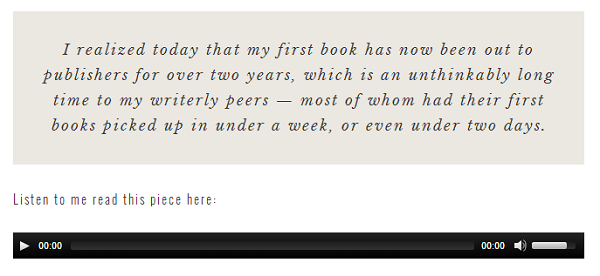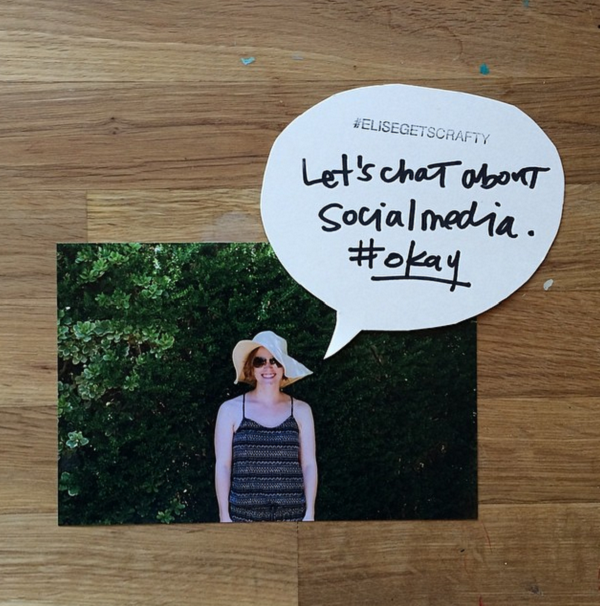
It’s painfully easy to believe that there’s nothing new on the internet.
A vignette of adorable, striped clothing we can’t afford ? Seen it.
A numbered list of ways you can improve something? I WRITE THOSE ALL THE TIME.
Interviews? Dur. A bunch of curated links? Hell, I tell all my clients to do that (because those posts are incredibly effective.)
But occasionally I stumble over something new and head-turning on the internet. Something that makes me think “Well, aren’t you clever?! I think you might have just reinvented the wheel! Or at least framed something in a particularly awesome and new way.”
And then I add those blog posts to a folder titled ‘non-boring post inspiration.’
If you’re looking for a bit of motivation, or just some reassurance that blogging is more than product roundups and personal essays, look no further. Here are 7 I’ve-never-seen-that-before blog posts that might suit you and your blog, too.
1. Taking stock

Posted by: Pip of Meet Me At Mike’s
Why it’s innovative: It’s community-building and meme-worthy. Lots of bloggers create posts that consist of their Instagram accounts or occasionally tell us what books they’re reading, but Pip’s 36-item list gives her readers an easy to digest but close look into her life - which readers usually love! It’s short, easy to read, and oddly fascinating. It’s also totally meme-worthy and I could see lots of other bloggers using this template and linking back to her.
Your spin on it: If you write a topic-specific blog you could create a list like this for you and your readers! If you’re food blogger it could be things like: currently eating, new recipe I’m trying, seasonal food I can’t wait to stock up on, latest kitchen purchase, cookbook I’m currently obsessed with, super unhealthy thing I love. You get the idea!
2. Links visually arranged by theme

Posted by: Brittany of The House That Lars Built
Why it’s innovative: This is really just a link roundup (and you know how I feel about those) but it’s been framed in a fun, thematic way. Readers are much more likely to click on those links and showcasing other bloggers’ work in such a pretty, professional way is incredibly flattering.
Your spin on it: Wouldn’t this be a cute, click-catching way to arrange links for a topic-specific blog? If you’re a beauty blogger, you could round up DIY beauty treatments for hair, face, hands, and feet. If you’re a fashion blogger, you could round up accessories for head, ears, neck, wrists, and feet.
3. The world’s shortest, most engaging travel post

Posted by: Amber of Code for Something
Why it’s innovative: It’s a short, engaging way to catalog memories of a specific time + place and share your travels (without boring your readers). If you’ve ever returned from a long, exciting trip and tried to tell your friends about it, you know that people have a verrrrrrry short attention span for travel stories. They weren’t there. They don’t care about squat toilets. The same goes for blog readers. They probably just want to see your photos and read the extremely abridged, bullet-pointed version of the trip. This post communicates novels of insight in just a few words.
Your spin on it: Tune into your senses when you’re someplace new. And then (succinctly) tell your readers about it.
4. A visual link roundup for an imaginary event

Posted by: Kelly at Design Crush
Why it’s innovative: Again, it’s pretty much a link roundup, but it’s organized in a gorgeous way that’s helping readers accomplish something specific. Like, lots of readers probably saw this and thought “Oh, me too! I’ve been wanting to throw an appetizer party! And lo, now I have all the resources!”
Your spin on it: You could do this with just about anything - recipes, products, and resources that will help your readers plan an awesome camping trip. A roundup of useful things that would help someone with a cross-country move. A collection of things for new moms. Possibilities = endless.
5. 10-second video tour (using still photos)
Posted by: Designsponge*
Why it’s innovative: We’ve all seen video tours of spaces or photo tours, but this is the first time I’ve seen still photos turned into a mini-video! It’s great for those of us with short attention spans and it’s a fantastic way to showcase something even if you’re not a super experienced videographer.
Your spin on it: The possibilities are endless: A tour of your space! Super simple DIYs! Recipes!
6. Audio-ified posts

Posted by: Esme Wang
Why it’s innovative: Everyone and their brother has a podcast, but what about blog posts? If you’re an aural learner, dyslexic, or you like to cook and clean while absorbing lovely content, the audio versions of blog posts are super useful. It would be particularly fun to listen to blog posts read by your favorite bloggers who have regional accents!
Your spin on it: I’m not sure there’s a way to spin this - just give it a try! Maybe go through your archives, make audio versions of your best stuff, and then tell your Twitter friends to check out your new and improved blog posts.
7. Glorious promotional Instagram photos

Posted by: Elise Blaha of Elise Joy
Why it’s innovative: Obviously, this isn’t so much a blog post as a way to promote blog posts - but it sure is clever, isn’t it? I’ve struggled to find ways to promote blog posts on Instagram, usually settling for one of the photos I use in the post. Which isn’t particularly engaging. This is so much more interesting!
Your take on it: Think about how you can use handwriting, actual photos, post its, tape, or even gift tags to create images that promote posts.
What are some of the most interesting, unusual blog posts you’ve seen lately? Leave links in the comments!
P.S. Need help coming up with blog post ideas? I can help with that!
photo by death to stock photo




































